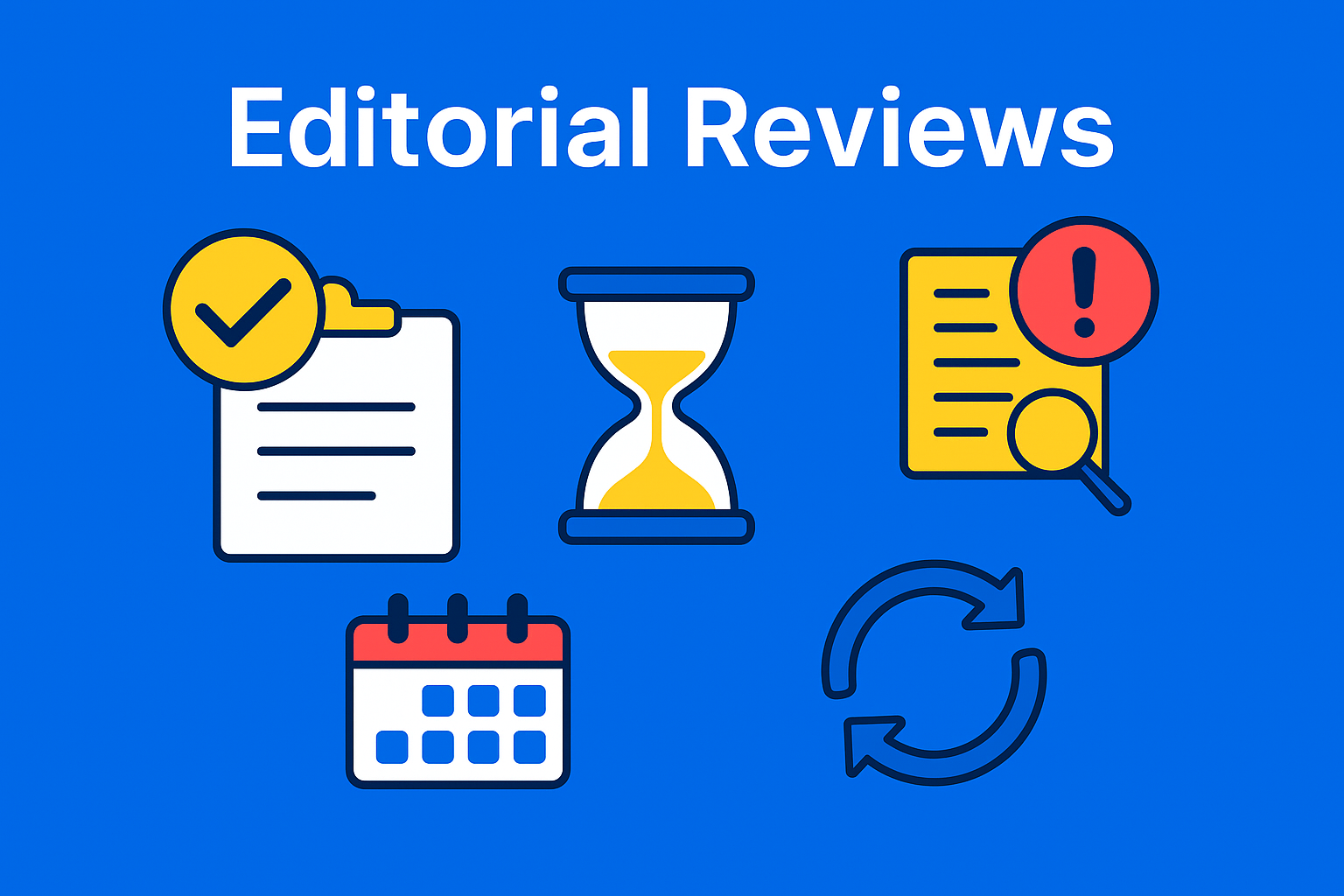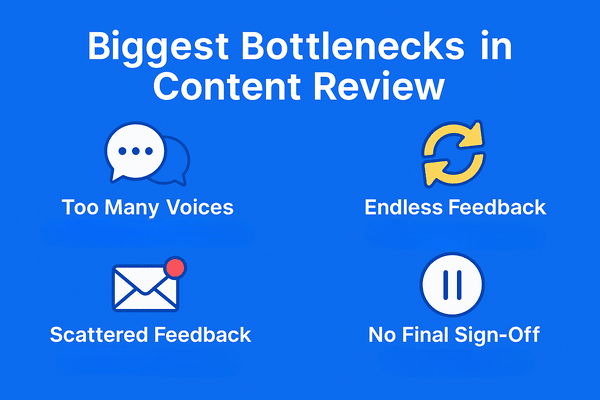Editorial Review Processes That Don’t Slow You Down
Editorial reviews are key to high-quality content, but they shouldn’t slow the team down. Clear roles, deadlines, and centralized feedback help avoid delays, bottlenecks, and endless revisions, keeping content moving quickly and efficiently toward publishing.

Keep content flowing: Don’t let editorial reviews slow your work
Editorial reviews are very important, but they should not stop everything. If you have been in a situation where your content is ready, but it keeps bouncing between editors and stakeholders, stuck in review limbo, deadlines get missed, momentum fades, and projects stop. Then this blog will help you.
A good review process should help your team, not hold it back. When it is smooth and well-structured, reviews sharpen your message, catch mistakes, and keep your brand voice strong.
In this post, we will dive into why reviews often cause delays, and how you can simplify the process. You will see how the right workflow keeps quality high and deadlines untouched—so that your content at no moment stands waiting for some new review.
🔑 Key Takeaways
- Clear roles prevent confusion – writer, editor, approver.
- Set deadlines for feedback to avoid endless review cycles.
- Keep feedback and edits centralized in one place.
- Limit review rounds to maintain speed and focus.
- Assign one decision-maker to approve final content.
- Structure your review process to support, not block, progress.
Why editorial reviews are important (but often feel like a pain)
Editorial reviews, everyone knows that they are important, but not everyone does them properly. When they are done well, they are the key for creating high-quality content. When they are poorly managed, they turn into endless losses of time that stop your whole process.
Here is why reviews are really important for content teams:
Catching mistakes before they go live
Even the best writers miss something; typographical errors, grammar slips, or incorrect facts. Reviews help for mistakes to be noticed before your audience sees them.
Maintaining a consistent brand voice
No matter who writes, your content always needs to sound like your brand. Reviews help that tone, style, and message stay consistent through every piece.
To make sure that content hits the target
Is the text aligned with your goals? Does it answer the needs of your audience? Reviews help for the content to be refined so that it is not just polished, but also effective.
Here is the problem: Reviews can slow everything down
Without structure, reviews turn into bottlenecks; unclear comments, too many people getting involved, or endless discussion about things that are not even important.
A review process without a clear plan can do more harm than good. It reduces productivity, creates confusion, and leads to missed deadlines.
Do you want your team to go faster and keep quality? It’s all about setting up a review system that is organized, focused, and keeps things moving.

The Biggest Bottlenecks in Content Review (and How They Slow You Down)
Let’s be real, every content team has hit that wall where the review process feels like it’s never going to end. Instead of moving things forward, it drags everything out. Here’s what usually gets in the way:
1. Too Many Voices, Not Enough Clarity
When everyone wants to give input, things get messy, fast. Without clear roles, content bounces from person to person, and no one’s sure who makes the final call.
2. Feedback That Just Won’t Stop
Ever had a draft go through 5, 6, maybe 10 rounds of changes? Without deadlines or a solid structure, feedback loops spiral, and that content never feels finished.
3. Feedback Scattered Across the Universe
Some comments are buried in emails, others lost in Slack, and a few hiding in Google Docs. Chasing down feedback wastes time, leads to missed edits, and sometimes double the work.
4. No One to Say “Go”
If no one owns the final sign-off, content just... sits there. Teams keep tweaking, unsure if they can hit publish without someone giving the green light.
Sound familiar? These bottlenecks are way too common, but they’re fixable. It all comes down to making it crystal clear who does what, where, and when. A bit of structure can seriously speed things up, so reviews help, not hold you back.
How to speed up your content reviews without losing quality
Editorial reviews are key to great content, but they don’t have to eat up all your time. With a bit of planning, your team can keep reviews efficient and low-stress. Here’s how to simplify the process without skipping the important parts:
Clearly define who does what
It’s not necessary for everyone to touch every part at every stage. Know your team’s roles:
- Writer: Writes the first draft, guided by the brief.
- Editor: Edits tone, clarity, grammar, and flow.
- Approver: Gives the final green light before publishing.
When roles are clear, tasks move faster and with much less confusion.
Set deadlines for feedback
Never-ending reviews are a recipe for delays. Give each stage a time frame:
Editors: 1–2 days for review.
Approvers: 1–2 days for approval.
Deadlines keep the process moving, especially when content needs to go live fast.
Keep everything in one place
Stop switching between emails, Slack threads, and random documents. Use one platform where your team can:
- Leave comments.
- Make edits.
- Approve content.
Centralizing everything ensures that nothing slips through the cracks and saves everyone a ton of back-and-forth.
Limit review rounds
With too many rounds, you risk over-editing and wasting time. Stick to a simple rule:
Round 1: Big-picture edits, structure, tone, key fixes.
Round 2: Final tweaks. Then, publish.
Done is better than perfect, especially when the process already takes too long.
Have one clear decision-maker
Assign someone with the authority to say, “This is ready.” No more endless tweaking or second-guessing. The final approver balances quality and speed, and helps the team stay confident in moving forward.
Follow these steps and you’ll spend less time stuck in feedback loops, and more time creating great content. A tighter review process means better teamwork, faster publishing, and less stress for everyone.
How EasyContent Makes Reviews Easier
There are many people who feel that the review process always goes back and forth between emails, notes, and confusion. That’s where EasyContent helps you. It keeps content teams on the right track and organized.
And here’s how:
With customizable workflows: You can easily assign roles and clear deadlines to the writer, editor, and approver. Everyone knows when and what to do.
Centralized feedback: You won’t have to search through emails or documents that are scattered everywhere. It’s easy to see what was said and what needs to be fixed because all feedback is in one place.
Real-time progress tracking: See immediately whether a piece of content is still in draft, under review, or ready to go live. No need to guess anymore.
With EasyContent you not only speed things up; you also make sure that the right people are doing the right jobs. Less chaos, less delays, and more great material on time. It makes review easy, just the way it should be.
Review smarter, not slower
At the end of the day, editorial reviews should help your content, not hold it back. A solid review process is not in adding extra steps, but in making sure that every piece of content gets the final touch it needs, without wasting time.
When you tighten how reviews are done, assign clear roles, stick to deadlines, and centralize feedback, you will not only go faster but also publish better content. The key is to stay organized and avoid getting stuck in endless edits.
Tools like EasyContent make your editorial workflow simpler, so your team can focus on creating, improving, and delivering the best possible content, on time, every time.
Start today and see that smooth reviews really exist!






